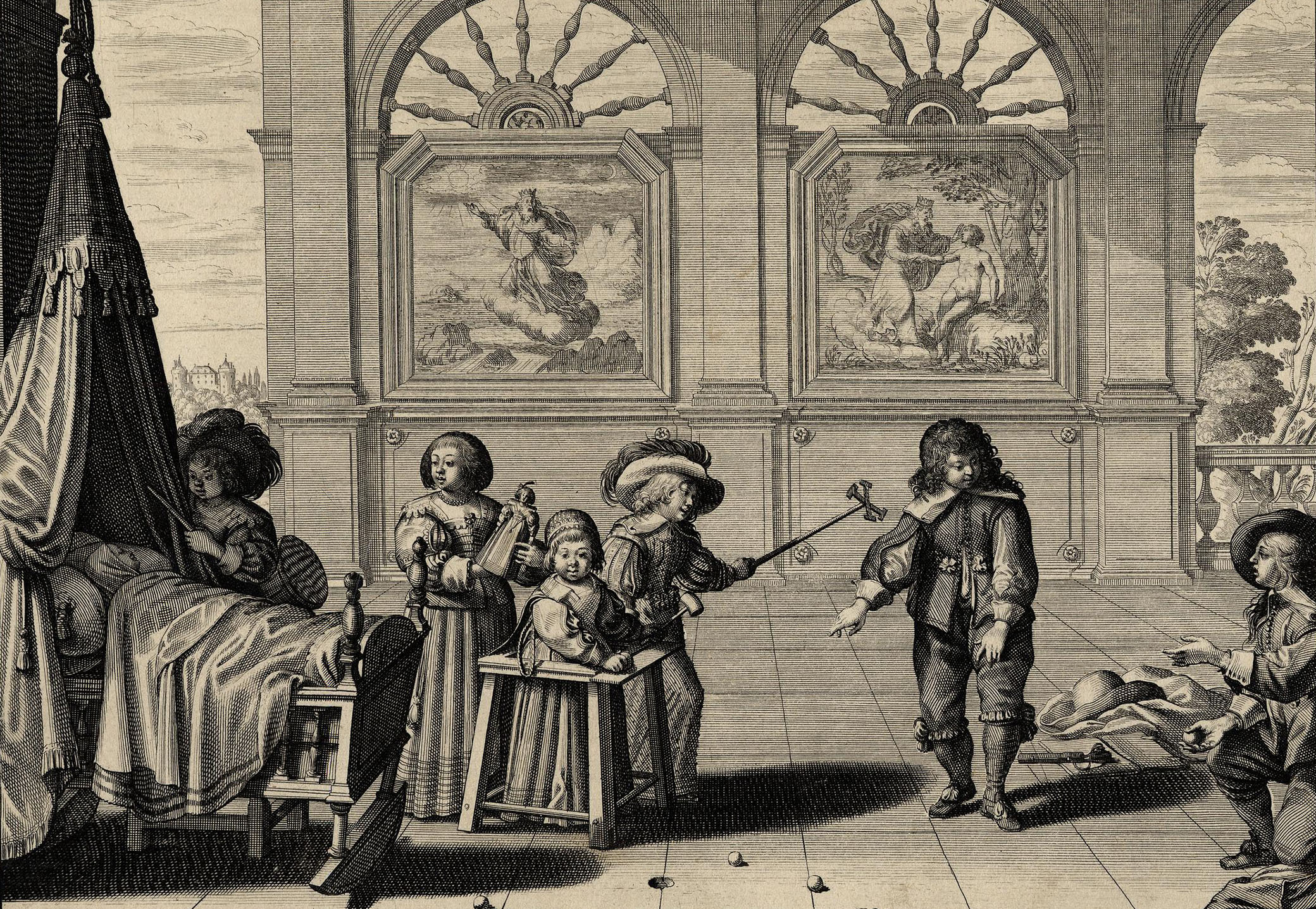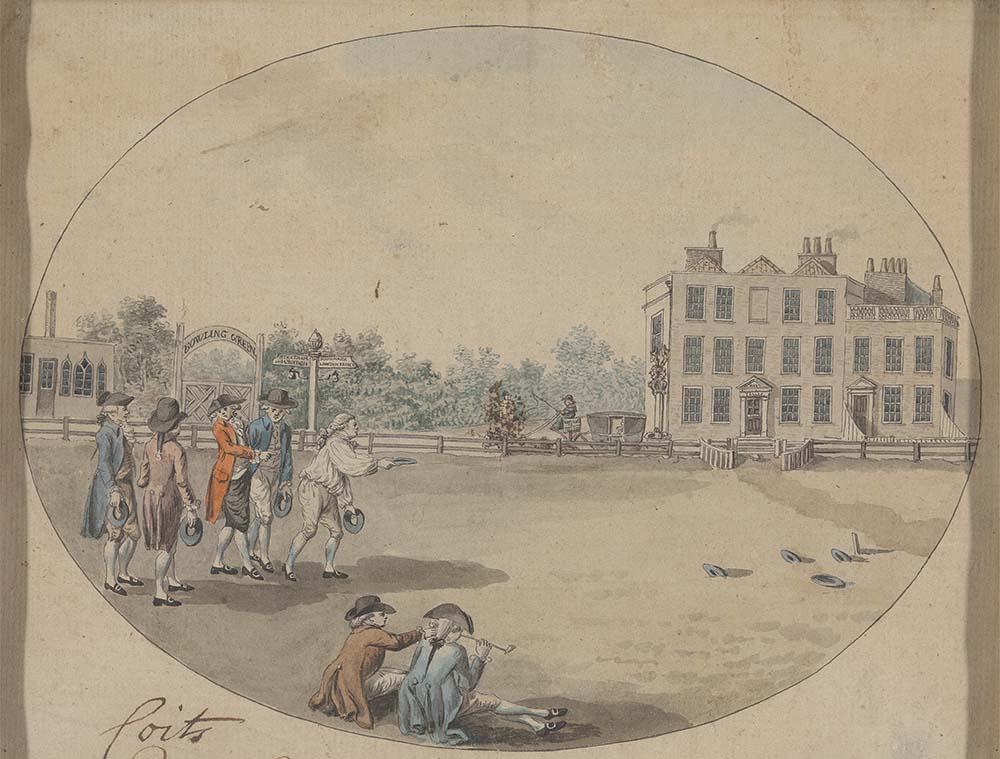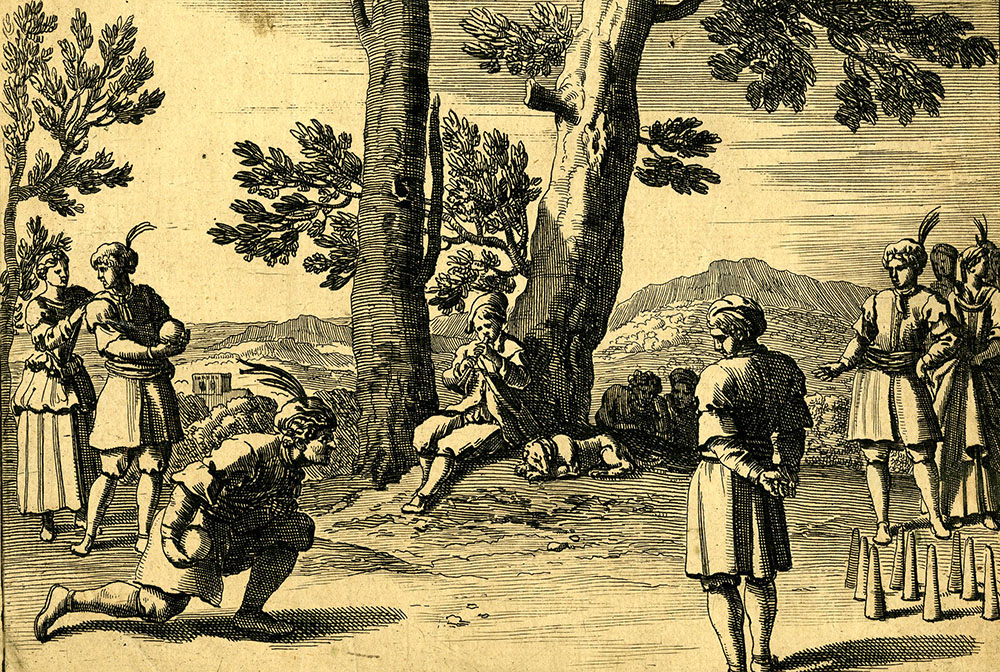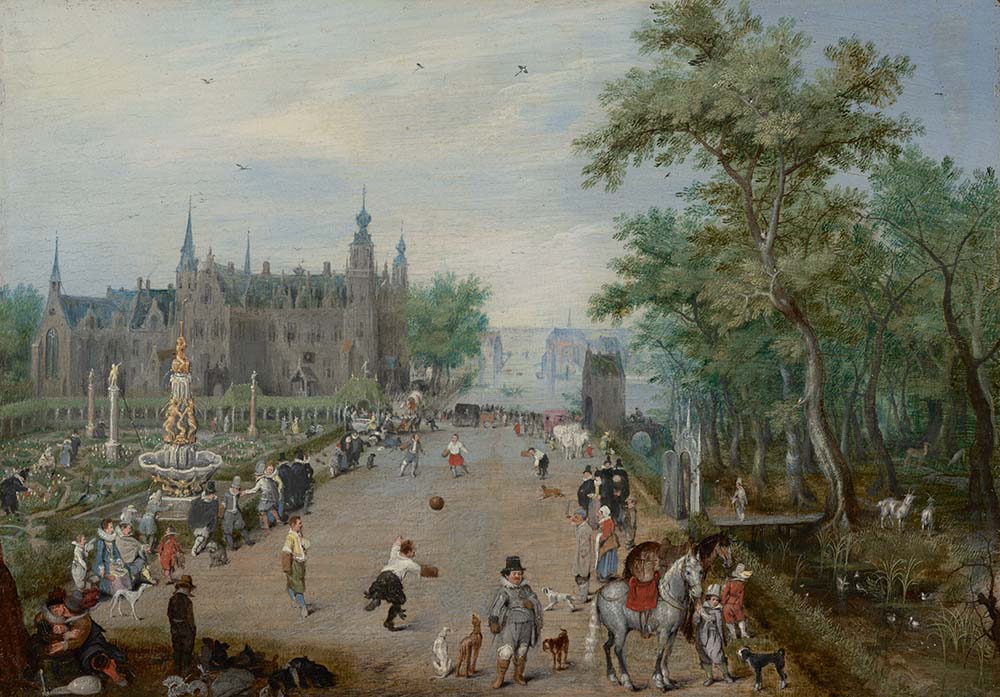
The Four Ages of Man, by Abraham Bosse, 1636. © The Trustees of the British Museum.
A vast number of games of skill were played by children and youths in Tudor and early Stuart England. A single play, Apollo Shroving, performed by the scholars of Hadleigh School, Suffolk, on Shrove Tuesday 1627, mentions (as being known to the boys) blind man’s buff, blow-point, check-stones, dice, football, hide and seek, leap-frog, morell (nine-men’s morris), mumble-the-peg, mumchance, nine holes, quoits, scourge-top, span-counter, spurn-point, tick-tack, trap-out, and truss.
Children’s games in Tudor England can be divided into those involving skill (manual dexterity or mental power) and those requiring physical strength. In the first category there could be actions using parts of the body alone: whistling, bird calls, popping noises, or tricks with the fingers. One of the latter, “handy-dandy,” in which small items are moved from hand to hand while the onlooker tries to guess where they are, is mentioned in the fourteenth century and gained an entry in Florio’s Italian dictionary of 1598: “bazzicchiare: to shake between the hands, to play ‘handy-dandy.’” A rare reference to another occurs in a school Latin dictionary of 1553, where the word scloppus (gun) is translated as “a pot [popping sound] made in the mouth with one finger, as children use to do.”
More interactive was “cherry-pit” or “cherry-stone”: the competitive game most closely associated with children and the least likely to be played by anyone much older. It involved throwing or flicking cherry stones at a hole or target which enabled scoring and competitive play, perhaps with the forfeiture of the stones that missed. “Buckle-pit,” mentioned by Thomas More in 1532, may have been a variant word, implying a contest to hit a pit.

“Penny-prick” consisted of aiming at a penny, perhaps to win it. Cob-nuts (large hazelnuts) were similar items of play. They could be used like cherry stones. Claudius Hollyband, in a book to teach Italian in 1583, describes boys saying “We will make a pit-hole and there cast our nuts.” The nuts were also the currency which the winner took and ate, because Hollyband’s boys complain that they have only rotten ones. Other ways of playing with nuts may have been in a kind of miniature game of bowls or throwing them individually to try to knock down a pile of themselves, again with the winner rewarded.
Other games of skill were played on a larger scale and needed more physical effort. These too were mainly adult pursuits and involved apparatus beyond the means of most children, although they could be copied in cruder ways. They included bowls: very popular among men in Tudor times, although Elyot considered the heavy balls as liable to injure the muscles. “Loggats,” first mentioned in 1541 and therefore a new game or a new name for an old one, involved throwing logs at a target in a similar manner to bowling. “Mumble-the-peg” was a knife-throwing game. The first player whose knife did not stick in the ground had to draw out with his teeth a peg driven into the earth.

There were many games of action, especially for adult men (at least in the records), and as with games of skill, what is said about men can be assumed in most cases to have been done by boys and youths, and in some cases by girls and women. These could include athletic feats and chasing. “Spurnpoint” has been suggested as a form of hopscotch. “Leapfrog,” jumping over another person’s back, is mentioned in Shakespeare’s Henry V. “Truss” seems to have been similar, involving one or more players lifting others.
Competitive running is mentioned in Oxford in the 1490s, and “a running place” occurs in a school Latin dictionary in 1553. Castiglione’s The Book of the Courtier, translated into English in 1561, recommended the nobility and gentry to practice running, jumping, wrestling, and throwing weights as a valuable part of military training. Running could also form part of a game. Crossing a space of ground from refuge to refuge while avoiding a catcher is recorded in medieval times. It included a ritual in which the chased and the chaser chanted a rhyme before the run took place. Both game and rhyme were still in use in Tudor times because they are recorded again by the Oxford scholar Gerald Langbaine, remembering his schooldays in the 1620s:
Chased: Pe, pe, postola, how many miles to Beverley?
Chaser: Eight, eight, and other eight.
Chased: Think you I shall get thither tonight?
Chaser: Yes, if your horse be good and light.
Running-and-chasing games were common under the names “base” or “prisoners’ base.” Shakespeare’s Cymbeline refers to “lads more like to run the country base” than to commit slaughter in battle. Such games often involved a prison area, in which those caught were held until all had been captured and a winner identified. A less strenuous version called “barley break” was also played in the early modern period. It required six participants, three of each sex, one couple of whom were placed in a central area called “hell” and the game involved them catching the others, and the captives joining them in the task. “Barley” appears to mean an immunity that was given or could be gained on a particular spot. Other active games recorded before 1600 included “king-by-your-leave” and “blind-man’s-buff,” both of which involved a player being blindfolded.
There is an unusually precise description of the first of these in the 1572 edition of Richard Huloet’s Latin dictionary:
King-by-your-leave: a play that children have, where one sitting blindfold in the middle hideth so till the rest have hidden themselves, and he then going to seek them, if any get his place in the mean space, that same is king in his room.
This leaves us wondering how the king could both defend his “seat” and capture other players, or why any player should have wished to be the pursuer rather than the pursued. “Hot cockles” was another variant, in which a player lay or knelt with the eyes covered, and tried to guess which player struck them on the back, possibly then chasing them as was the custom when I played it in the 1940s.
There were numerous ball games, which might involve using a hand, foot, or bat of some kind. One was “stool-ball,” recorded from 1475, in which the stool was apparently a wicket, defended by a player from the bowler by holding a bat, presumably with the chance of scoring runs or points. The game was sufficiently harmless to be played by girls or women, and there are several literary references to the fact. Alternatively it might take place around Easter and involve both young men and women, with a pudding as the prize for the victors. “Trap-out” and “trap-ball” were probably forms of “knur and spell,” in which a ball is released from a trap and hit with a bat.

Other handball and football games gathered in large numbers of boys or youths, and were therefore popular rather than aristocratic sports. They probably took different forms from place to place. The Cornish historian Richard Carew, writing in 1602, described one variety, which he termed “hurling” and was, in fact, chiefly a form of handball since he does not mention kicking. It could be done in two ways. “Hurling to goals” was played by teams of fifteen, twenty, or thirty players on either side. It took place in a limited area with two goals, each having two goalkeepers. Each player formed a pair with an opponent. On getting the ball, the player could hold or throw it, at which point his opponent could tackle him by holding him and be fended off with punches. If he fell on the ground, he had to yield the ball. Having escaped the opponent, anyone could try to stop him. There were recognized rules, including an offside convention. Carew gives these for east Cornwall, which he knew, but others no doubt prevailed in other places. The matches in his own county commonly took place after weddings, which brought together enough youths or men to form teams.
Carew describes a second form of the game as “hurling to the country,” which was a larger and less structured activity. It was organized by two or more gentlemen who brought together men from as many as six parishes to play it. The goals were houses three or four miles apart, and there was no restriction on the number of players or much in terms of rules. A ball was used, small and of silver, which could be held or thrown, and the player could be attacked by any number of opponents but, if forced to the ground, had to surrender the ball. It was even possible to riders to join in and seize the ball if they could. The struggle went “over hills, dales, hedges, ditches, yea, and through bushes, briars, mires, plashes, and rivers, so as you shall sometimes see twenty or thirty lie tugging together in the water.” Carew commended the game for the manliness and courage required, but admitted that the result was often “bloody pates, bones broken and out of joint, and such bruises as serve to shorten their days.”
The resemblance between handball and football of this kind with military fighting is confirmed from other sources. One name for such a game was “camp-ball” or “camping,” from a verb “camp” which means “to fight.” The commotions that broke out in England in 1549 were called by contemporaries “camping” or “the camping time.” These were the risings in Devon and Cornwall against the new Book of Common Prayer, and that in Norfolk caused by economic grievances. Tudor writers who noticed football disliked its freedom from restraint, its potentially subversive violence, and (probably) its egalitarianism. It did not allow any respect for rank, and Elyot declared it should “be utterly [rejected] by noblemen.”
Richard Mulcaster, writing in 1581, called it the activity “of a rude multitude, with bursting of shins and breaking of legs…neither civil nor worthy the name of any train [passage] to health.” Two years later, the Puritan writer Philip Stubbes added his condemnation of it as more of ‘a bloody and murthering practice than a fellowly sport or pastime.” Men lay in wait for their enemies and attacked them, “so that by this means sometimes their necks are broken, sometimes their backs, sometimes their legs, sometimes their arms.” He dismissed it as having any place as a Sunday recreation (and by implication at any other time) because, so he claimed in a fine array of synonyms, it leads to “envy, malice, rancor, choler, hatred, displeasure, enmity, and what not else!”
It was indeed possible for communal games of action to turn into mimic wars, under the inspiration of contemporary events. Children in London had chosen kings and fought battles in 1400, six months after Richard II was overthrown by Henry IV. In 1548 the boys of Bodmin School in Cornwall, who were accustomed to divide into sides for their games, formed two religious parties: the old religion and the new. This was at the time that the Protestant Reformation under Edward VI was being enforced across the country. The division, which Richard Carew remembered long afterwards, led to rough conflicts, “each party knowing and still keeping the same companions and captain.” It ended when one boy made a gun from an old candlestick, charged it with gunpowder and stone, and succeeded in killing a calf, after which the schoolmaster intervened with a good whipping of those concerned. This affair had a sequel in London in March 1554, after the failure of Wyatt’s rebellion against Mary Tudor. Boys gathered in Finsbury Fields outside the city “to play a new game, some took Wyatt’s part and some the queen’s and made a combat in the fields.” The city authorities took immediate action over such a sensitive matter, and many of the participants were arrested and shut up in the Guildhall.
Excerpted from Tudor Children by Nicholas Orme. Copyright © 2023 by Nicolas Orme. Reprinted by permission of Yale University Press.
